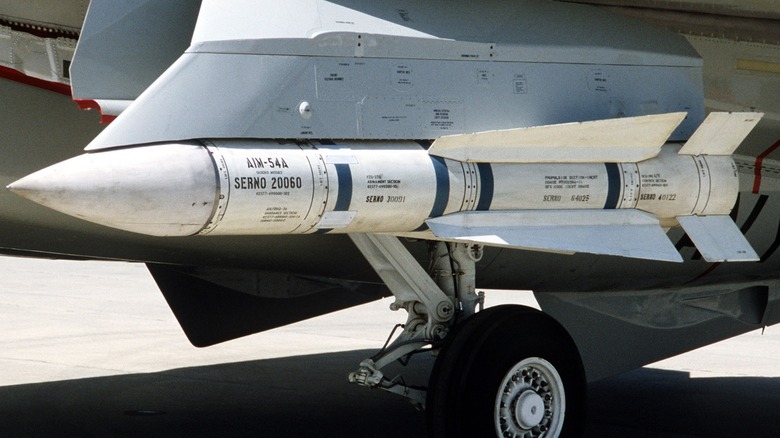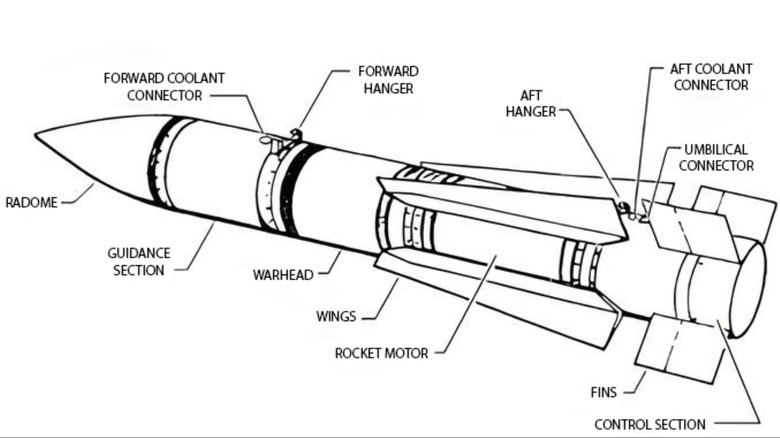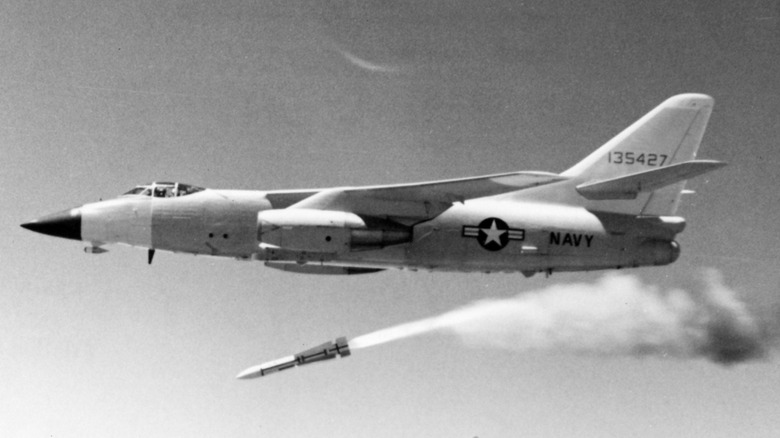What's The Phoenix Missile And How Did It Change Air Combat Forever?
Since World War I, aviators have found new and impressive ways to dominate the airspace. Initially, this was through dogfighting with large-caliber machine guns. Eventually, with the advent of reliable rocket technology, guns gave way to missiles, and there are many types. The largest missiles, such as intercontinental ballistic missiles (ICBMs), are massive, but the smaller ones are nonetheless deadly to other aircraft. Indeed, air-to-air missiles have changed how air combat works.
Gone are the days when pilots had to get in close to their enemies, and there's a variety of options when it comes to firing anti-aircraft missiles (which submarines can do, too). If you've watched a movie and heard a pilot say their callsign before "Fox One" or another number, that's to do with missile types. Fox One is for a missile with a semi-active radar, while Fox Two indicates a heat-seeking missile. Fox Three is a game-changer, referring to a missile with active radar homing. This code was first used in 1974 for the newly arrived Phoenix missile.
The AIM-54 Phoenix was the first such missile, and while there are countermeasures to defend against them, they're considerably more powerful and deadlier than those that fall within Foxes One and Two. When the Phoenix was introduced, it pushed the Soviet Union to create something similar, and the technological arms race has produced a wide variety in the years since. Here's what made the Phoenix missile special and how it changed the way aerial wars are fought.
The AIM-54 Phoenix
Before the development of an active-radar-guided air-to-air missile, missiles had to be fired while the aircraft maintained a radar lock on a target. If the lock was lost, the missile failed to find its target. Heat-seeking missiles work better in locking onto a heat signature, but infrared flares are an effective countermeasure. Chaff is a countermeasure to active radar, but the AIM-54 Phoenix has some aces up its sleeve. Its radar could lock onto a target up to 100 miles away and be fired concurrently with five additional missiles, which could independently track and hit separate targets. This innovation made the Phoenix incredibly deadly and versatile.
The missile itself is 13 feet long and weighs 1,024 pounds. It has a diameter of 15 inches with a wingspan of 3 feet. They could be loaded with a proximity-fuse or high-explosive 135-pound warhead, and they could fly at speeds exceeding Mach 3.9 (3,000 mph).
Multiple variants have been developed over the years, resulting in the AIM-54C. This variant is more reliable and has other improvements over the original design. The missile was only ever carried by the F-14 Tomcat, which was featured in "Top Gun," where many pilots fired a "Fox Three" at an enemy aircraft. Each F-14 could carry six, and the missile had widespread success, not with the U.S., but with Iran. The nation used them extensively during the Iran-Iraq War and remains the only nation still using the Phoenix, though they've cloned and modified the design.
How the AIM-54 Phoenix changed air combat forever
Any new military technology can alter how wars are fought, and over the years this has happened time and time again. When it comes to air combat and the AIM-54 Phoenix's role in changing it, the buck stops at its highly advanced and capable radar system. The Phoenix was outfitted with the AN/AWG-9 radar system that enabled the targeting of aircraft beyond visual range using multiple missiles simultaneously. It was the first long-range air-to-air missile with active radar, and it operated cunningly.
To reach a target 100 miles away, the missile would reduce its atmospheric drag by climbing to 81,400 to 100,000 feet, depending on the model. This let it cruise for a significant distance, so enemy aircraft might not even realize they'd been fired upon until the missile was well within range. The Phoenix was the only long-range air-to-air missile the Navy employed during its service life. After retiring it in 2004, the Navy switched to the medium-range AIM-120C/D AMRAAM missiles, which it still uses today.
The Phoenix proved its effectiveness against Iraqi-flown MiG fighters during the Iran-Iraq War, which saw the missile down multiple enemy aircraft. While U.S. naval aviators fired the Phoenix on several occasions, they never took down an enemy aircraft in combat. Only Iran can make that claim, but that simply proves how much of a game-changer the missile was, since it was incredibly effective against Soviet-built Iraqi fighters incapable of avoiding its lethality.


